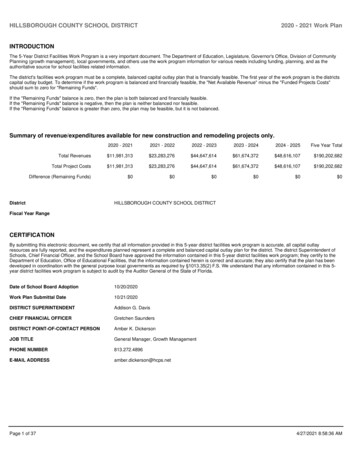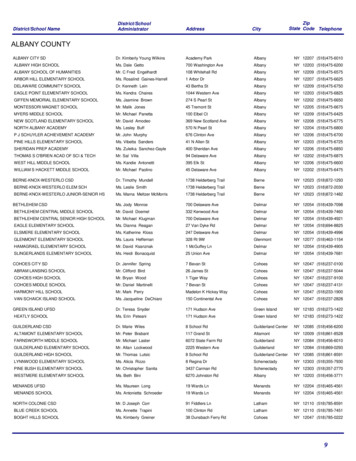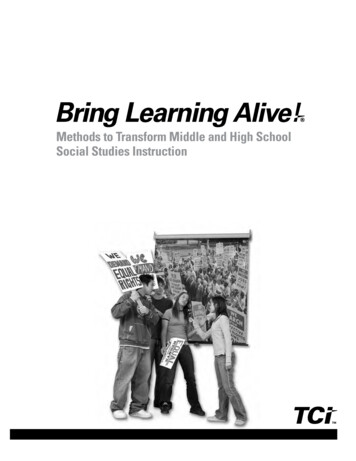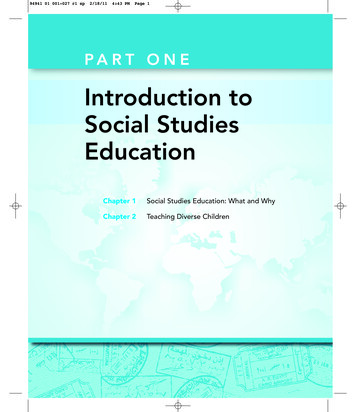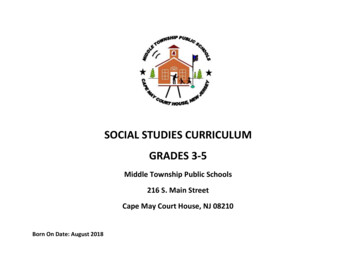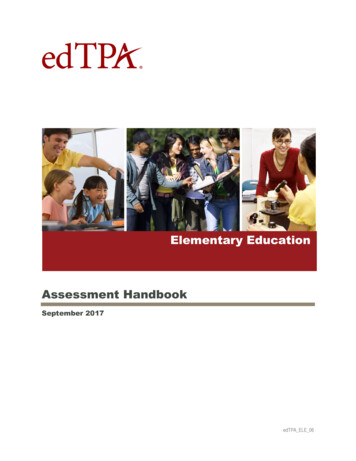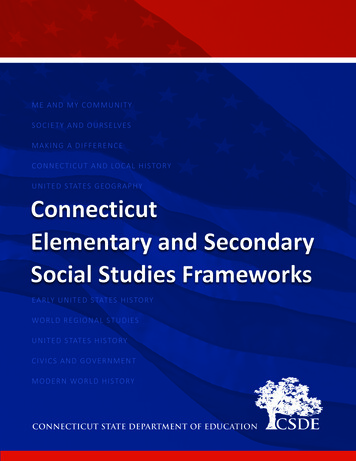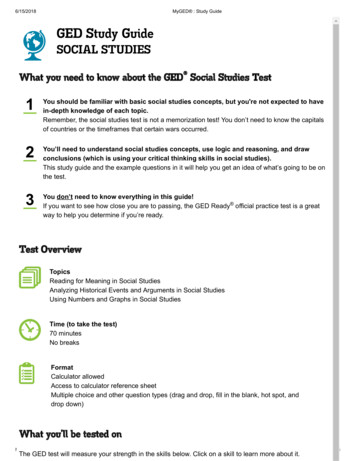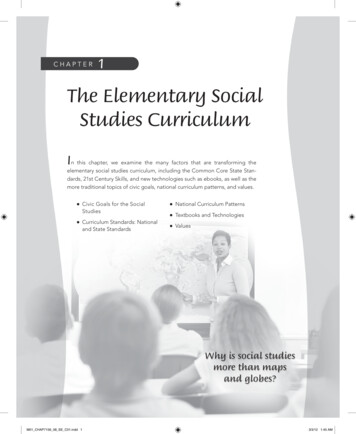
Transcription
CHAPTER1The Elementary SocialStudies CurriculumIn this chapter, we examine the many factors that are transforming the lementary social studies curriculum, including the Common Core State Stanedards, 21st Century Skills, and new technologies such as ebooks, as well as themore traditional topics of civic goals, national curriculum patterns, and values. Civic Goals for the SocialStudiesCurriculum Standards: Nationaland State Standards National Curriculum Patterns Textbooks and Technologies ValuesWhy is social studiesmore than mapsand globes?M01 CHAP7156 08 SE C01.indd 13/3/12 1:45 AM
2 C h a p t e r 1 / The Elementary Social Studies CurriculumWhat Are Your Images of the Social Studies?Welcome to the world of social studies! What do you remember about your elementarysocial studies program? If any of the following activities seem familiar, jot down on apiece of paper whether the memory is pleasant. Feel free to add other activities that youremember.Learning about the Pilgrims at ThanksgivingGoing on a field trip to a site where your state’s American Indians livedAnswering the questions at the end of a textbook chapterWriting to foreign consuls and embassies for information about your assigned country1.1Reenacting pioneer lifeSinging patriotic songsWhat Works Best?Preparing and serving different ethnic foodsThis exercise points out that yourdays as an elementary studentDrawing neighborhood mapsyears ago are influencing yourWorking on a committee for a group projectimage of the social studies. YourLearning about the immigrant groups from which youimages act as a filter as you make judgments aboutcamewhat a good social studies program is and what methods should be used to achieve social studies goals. DoViewing filmsyou think teachers teach much in the way they wereWriting a book report on a famous Americantaught? What activities should be curtailed or not reRole-playing a characterceive as much emphasis? Finding new informationSmall Group WorkWhat Are the Goals of Social Studies?From your examination of images, you can see that teachers have different understand-ings of what a good social studies program is and what methods should be used to achievesocial studies goals. However, almost everyone agrees that the primary purpose, mission,rationale, or main goal of social studies is civic education, less frequently called citizenship education or civic competence. These definitions stress that all students need theknowledge, skills, and democratic dispositions to be active and to participate in public life.Civic education means that all students must be prepared to interact with the increasingdiversity of their communities and the nation, as well as understand the complexity of local,national, and global issues that are shaping the world.Goals are the broad statements of desired outcomes. Goals are long-term ideals orvalues that are socially determined. In education, they provide the general guides for thecurriculum. Goals come before themes and content standards. Having an end in mind clarifies the purposes of content taught and the methods employed.There are four major subgoals of civic education.1.2.3.4.M01 CHAP7156 08 SE C01.indd 2To acquire knowledge from history, the social sciences, and related areasTo develop skills to think and to process informationTo develop appropriate democratic values, beliefs, and dispositionsTo have opportunities for civic participation3/3/12 1:45 AM
What Are the Goals of Social Studies? 3These four goals are not separate and discrete. Usually they are intertwined and overlapping (see Figure 1.1). You may find in some state standards or frameworks that two goalsare combined. Social participation may be regarded as a democratic value or the goal maybe stated as “skill attainment and social participation.” The knowledge goal can be referredto as “knowledge and cultural understanding” or “democratic understanding and civic values.” Values may sometimes be called civic values to differentiate them from personal values. But regardless of how the goals are combined or written, together they form the basicgoals of a social studies program. Although these goals may take several years of studentlearning, the schools can and should focus their social studies program on these four mainsocial studies goals, realizing that goals are not achieved in one day, one week, or even oneyear. Goals such as good health and good citizenship are pursued by individuals for decadesand in a certain sense are never completely achieved.As these goals indicate, social studies is about people and, thus, builds on an inherentlyhigh interest. Each of us is concerned about self, family, and friends, and social studies isdesigned to help us understand ourselves and our nearby neighbors, as well as those wholive halfway around the world. Creative social studies instruction offers the possibilityof humane individuals who incorporate basic American values such as equality, freedom,and respect for property and who are able to put these values into action through effectiveparticipation in the classroom, school, community, nation, and the world. Again, this emphasizes the main purpose of the social studies curriculum: civic education.Frequently, the process of learning has emotional values attached to it. Did you hatemath in school? Did you love music? For example, when students study pollution, theyFigure 1.1Goals of the Social StudiesCitizenshipial ParticipationcoSet yemocratic SociDin aslueVaJusticeEqualityBill of RightsFreedom of speech,religion, etc.HistoryKnowledgerces of ContentSouInformaleffectiveparticipationin classroom,school,community,nation,worldNeeds ofSocialthe studentNeeds and Sciencesgoals of societyHumanitiesBor asicRe StudLis adin ySp tenin geaIntellectualk gTim Writi ingor critical/e-S ngcreativepacethinkingerInt onallrspe socia ionro cipatr tipaSkillsM01 CHAP7156 08 SE C01.indd 33/3/12 1:45 AM
4 C h a p t e r 1 / The Elementary Social Studies Curriculumusually acquire opinions or attitudes about it. Emotional concerns such as racism in thecommunity can have a striking impact on both subject area and students’ skill development.Certain skills such as writing or thinking may be taught in school, but there is no guaranteethat students will make use of them. Unless students have a commitment to, a need for, ora willingness to use the skills they have learned, those skills will be of little value either tothe students or to society. All this underlines the connections among the four main goalsof a social studies education; although we may speak of each one separately, we must notforget their inherent interrelationships.What Is Social Studies?Given the importance of social studies for all students, what knowledge and skillsshould be taught in the elementary schools? What should be the appropriate content ordefining attributes of social studies? Where does one start since there are thousands ofpossible social studies topics ranging from ancient civilization to present day energyissues? There are two main approaches: the social studies approach and the singlediscipline approach.The National Council for the Social Studies (NCSS), established in 1921, is the nationalprofessional organization of teachers concerned about social studies. The national organization publishes Social Education and, for the elementary grades, Social Studies and the YoungLearner. In addition, NCSS also has many state and regional councils. Most state councilsalso publish journals and newsletters for their members, in addition to holding annual conferences. NCSS is the major advocate for the teaching of social studies, and along with the statecouncils tries to influence legislation concerning social studies. Your membership in NCSSand your state or regional council could help your professional development; they wouldwelcome your membership. In 1992, NCSS adopted its integrated definition of the field.Social studies is the integrated study of the social sciences and humanities to promote civiccompetence. Within the school program, social studies provides coordinated, systematicstudy drawing upon such disciplines as anthropology, archaeology, economics, geography,history, law, philosophy, political science, psychology, religion, and sociology, as well asappropriate content from the humanities, mathematics, and natural sciences. The primarypurpose of social studies is to help young people develop the ability to make informed andreasoned decisions for the public good as citizens of a culturally diverse, democratic societyin an interdependent world.1In 2010, NCSS (www.ncss.org) revised its older 1994 standards, reaffirming its commitment toan integrated social studies approach drawing content from seven disciplines and three broadlybased themes. These revised standards maintained the ten major curriculum themes basic tosocial studies learning (Table 1.1). These Ten Themes are curriculum standards to select content for the K–12 social studies program, while also including four main skills: (1) literacy,(2) critical thinking, (3) learning strategies (decision making, inquiry learning, etc.), (4) personalinteraction and civic engagement strategies. In addition, the report contained a sharper focuson purposes, questions for exploration, knowledge, processes, and products. The ten themesstress using broad, multidisciplinary areas of learning in teaching social studies, notjust a single discipline. However, they are not content standards that provide a detailedTask Force of the National Council for the Social Studies, Expectations of Excellence: Curriculum Standards forSocial Studies, Bulletin 89 (Washington, DC: National Council for the Social Studies, 1994), 3.1M01 CHAP7156 08 SE C01.indd 43/3/12 1:45 AM
What Is Social Studies? 5Ta b l e 1 . 1 he Ten Themes of the National CurriculumTStandards for Social StudiesSeven themes that are based on the major concepts of history and the social sciences:1. Culture (anthropology)2. Time, continuity, and change (history)3. People, places, and environment (geography)4. Individual development and identity (psychology)5. Individuals, groups, and institutions (sociology)6. Power, authority, and governance (political science)7. Production, distribution, and consumption (economics)Three themes that are broadly based and include many subject areas:8. Science, technology, and society9. Global connections10. Civic ideals and practiceSource: National Curriculum Standards for Social Studies, Bulletin 111 (Washington, DC: National Council forthe Social Studies, 2010), 4.description of content and methodology. As shown in Figure 1.2, NCSS advocates a powerfuland meaningful form of social studies teaching and learning.In contrast to NCSS’s social studies integrated approach, the single-discipline approachbelieves that the content focus should be a single discipline such as history in which studentswill learn both important content in the field and the methods used by scholars (historians inthis case) in researching their field of knowledge. The single-discipline approach probablyhas more supporters in the middle and high schools. There teachers may identify themselvesas “ I teach history” or “I am an econ teacher” rather than identifying themselves as a socialstudies teacher.Figure 1.2NCSS’s Powerful Social Studies ParadigmMeaningfulConnects to students’own experiences; issignificantChallengingUses thought-stimulatinginquiry assignmentsMake powerfulsocial studiesValue-BasedEvaluates ethicalissues and controversiesInterpretiveCrosses disciplinesActiveInvolves studentsand teachersM01 CHAP7156 08 SE C01.indd 53/3/12 1:45 AM
6 C h a p t e r 1 / The Elementary Social Studies CurriculumWhat Is in a Name?In real practice, a considerable overlap exists between the social studies approach and thesingle-discipline approach. Both models have as their main goal the development of informed, responsible, active citizens. Both approaches emphasize history. Even in the socialstudies approach, history is typically used as the organizing framework for instruction.Equal time is not given to the other social sciences.Both approaches advocate that improvement should be made in the teaching of socialstudies. Therefore, what actually goes on in the classroom is probably more important thanthe label used. However, this text will generally use the term social studies except in specific discussions of subject areas.Interpreting the Goal of Civic EducationAt a general level everyone espouses civic education, but individuals and groups vary ontheir definition of civic education and what a good citizen does. Robert Barr, a social studieseducator, and his colleagues defined the first three main social studies traditions, shown inTable 1.2. Note that all the approaches emphasize the broad goal of citizenship educationbut differ on how to achieve this goal.In a more recent analysis of civic education approaches, Westheimer and Kahne2 outlined three main conceptions of the “good” citizen.1. personally responsible citizen—more the character education approach2. participatory citizen—active member of the community3. justice-oriented citizen—critically assesses structuresNote that each of these conceptions differs on what skills and values students need tobecome good citizens.Your ChoiceYou can see now that definitions of social studies content will vary depending on the valuesystem or philosophical orientation of the teacher or curriculum planner. The citizenshiptransmission approach tends to emphasize U.S. history and our nation’s high ideals andachievements. The social science/history approach usescontent from the various social science disciplines and1.1history with a view to understanding the major conceptsand the respective methods of research. The reflectiveCompare the Approachesinquiry and social-justice approaches use almost anycontent as long as it encourages thinking on the partWhich approach or model (see Table 1.2 andof students. In addition, the social-justice approachconsider the other civic education approachesemphasizes students taking action. The child-centeredmentioned) do you feel most comfortable with?approach focuses on personal development. AdvoList the strengths and weaknesses of each approachcates of global and multicultural education also wanton a piece of paper. Which approaches are seen mostfrequently in elementary classrooms? their approaches to be considered as major goals ofthe social studies.On Your OwnJoel Westheimer and Joseph Kahne, “Educating the ‘Good’ Citizen: The Politics of School-Based Civic Education Programs.” Paper presented at the Annual Meeting of the American Political Science Association, Boston,MA, 2002.2M01 CHAP7156 08 SE C01.indd 63/3/12 1:45 AM
What Should Be Taught? National Standards and State Standards 7Ta b l e 1 . 2Different Approaches to Civic EducationApproachGoals of Civic Education1. Citizenship transmissionStudents are taught traditional knowledge and valuesas a framework for m aking decisions.2. Social science/historyStudents master social science/history concepts, generalizations, and methods.3. Reflective inquiryStudents use knowledge and thinking to make decisionsand to solve problems.4. Social justiceStudents develop understanding and skills neededto critique and t ransform society; often a focus on injustice/inequality.5. Child-centeredStudents develop a positive self-concept and a strongsense of personal e fficacy.Source: Robert D. Barr, James L. Barth, and S. Samuel Shermis, Defining the Social Studies, Bulletin 51(Washington, DC: National Council for the Social Studies, 1977). Reprinted with permission of the NationalCouncil for the Social Studies.What Should Be Taught? National Standardsand State StandardsFor the past thirty years or so, many parents and critics have felt that the public schools arenot making the grade in terms of student achievement. They are aware of international reports of the low ranking of U.S. students in science and math literacy, causing them to worrywhether our young people will be able to compete in the global economy. In addition, thecontinued achievement gap between the higher scores of White and Asian American studentsas compared to African American and Hispanic students is also a great concern.Responding to the public’s demand for reform, the use of standards—what teachersare supposed to teach and students are expected to know (content standards) and be able todo (performance standards)—has been advocated. Standards can help both teachers andstudents to be clear about their purposes in developing explicit goals for learning. Studentscan find standards helpful when teachers spell out criteria for high-quality work, explainhow the work will be assessed, and give examples of what the work looks like. Studentsthen have a better idea of what to do and how to do it. When goals and expectations are veryclear, more students can meet them. Standards also can address the issue of discrepancyin what is actually taught by different teachers. Within the same school and next door toeach other in the same grade, teachers can vary tremendously in what content and skills aretaught in various subject areas.From National Social Studies Standardsto State StandardsIn addition to the NCSS standards published in 1994 (later revised in 2010), organizationsin four subject areas—history, geography, civics and economics—also produced standardsfor their respective fields (see Chapters 5–8 for more discussion). However, in 1994–1995,M01 CHAP7156 08 SE C01.indd 73/3/12 1:45 AM
8 C h a p t e r 1 / The Elementary Social Studies Curriculuma proposed first set of national history standards, funded by the federal government, engendered a fierce national controversy, with critics complaining about anti-European bias andan emphasis on negative aspects of U.S. history (Chapter 5). The political outcry over theproposed national history standards ended any possibility of national consensus on historystandards at that time. In addition, concerns about federal control of education shifted thedevelopment of standards to the states. Forty-eight states then developed their own socialstudies standards, often built on a compilation of national standards developed by NCSS andthe four subject areas—history, civics, geography, and economics. These state social studiesstandards varied greatly, with critics finding a majority of state standards faulty in being toobroad, too low in expectations, and too poorly written to be really useful to teachers and students.Changing States’ Roles and NCLBBy 2001, both President George W. Bush and Congress were not satisfied with the progress the states had made. State standards were especially failing four subgroups of students:those from low-income families, minority students, English learners (ELs), and studentswith disabilities. A bipartisan Congress then passed the Elementary and Secondary Education Act (ESEA), the largest reform act in a quarter century. ESEA is commonly known asNo Child Left Behind (NCLB), with its commitment to standards-based reform.Through NCLB, all schools were to be held to high, measurable standards set by theindividual states to raise student achievement for all groups. The NCLB Act mandatedbroad accountability, requiring all states to test children in grades 3–8 in reading, math, andscience. Furthermore, schools failing to achieve specific performance targets faced serioussanctions, including providing vouchers to parents for out-of-school programs and eventually replacing the school staff or converting failing schools to charter schools.This ambitious act required states to establish their own annual tests aligned with theirown state standards. Standards were to be clear, with measurable goals focused on basicskills and essential knowledge. This has resulted in great diversity among state standardsand what a given state considers to be proficient students.Examples of State Social Studies StandardsLet us examine two different states’ standards for the second grade—Massachusetts (Table 1.3)and California (Table 1.4)—to illustrate both the similarities and differences between different state standards. Both states’ social studies standards received high ratings comparedTa b l e 1 . 3Grade Two E Pluribus Unum: From Many OneSecond graders study world and United States history, geography, economics, and government by learningmore about who Americans are and where they came from. They explore their own family’s history and listento or read of a variety of teacher- or student-selected stories about: distinctive individuals, peoples, achievements, customs, events, places, or landmarks from long ago and around the world. Students learn more economic concepts by identifying producers, consumers, buyers, and sellers in their own communities.Grade 2 Concepts and SkillsStudents should be able to:Apply concepts and skills learned in previous grades.M01 CHAP7156 08 SE C01.indd 83/3/12 1:45 AM
What Should Be Taught? National Standards and State Standards 9Ta b l e 1 . 3(Continued)History and Geography1. Use a calendar to identify days, weeks, months, years, and seasons. (H)2. Use correct words and phases related to time (now, in the past, in the future), changing historical periods(other times, other places), and causation (because, reasons). (H)3. Order events in the student’s life (e.g., the year he or she was born, started school, or moved to a newneighborhood) or in the history of countries studied. (H)4. Describe how maps and globes depict geographical information in different ways. (G)5. Read globes and maps and follow narrative accounts using them. (G, H)Civics and Government6. Define and give examples of some of the rights and responsibilities that students as citizens have in the school(e.g., student have the right to vote in a class election and have the responsibility to follow school rules). (C)7. Give examples of fictional characters or real people in the school or community who were good leadersand good citizens, and explain the qualities that made them admirable (e.g., honesty, dependability, modesty, trustworthiness, courage). (C)Economics8. Give examples of people in the school and community who are both producers and consumers. (E)9. Explain what buyers and sellers are and give examples of goods and services that are bought and sold intheir community. (E)Grade 2 Learning StandardsBuilding on knowledge from previous years, students should be able to:2.1On a map of the world, locate all of the continents: North America, South America, Europe, Asia, Africa,Australia, and Antarctica. (G)2.2 Locate the current boundaries of the United States, Canada, and Mexico. (G)2.3 Locate the oceans of the world: Arctic, Atlantic, Indian, Pacific, and Southern Oceans. (G)2.4 Locate five major rivers in the world: the Mississippi, Amazon, Volga, Yangtze, and Nile. (G)2.5 Locate major mountains or mountain ranges in the world such as the Andes, Alps, Himalayas, Mt.Everest, Mt. McKinley, and the Rocky Mountains. (G)2.6 Explain the difference between a continent and a country and give examples of each. (G)2.7 On a map of the world, locate the continent, regions, or then the countries from which students, theirparents, guardians, grandparents, or other relatives or ancestors came. With the help of familymembers and the school librarian, describe traditional food, customs, sports and games, and the musicof the place they came from. (G, C)2.8 With the help of the school librarian, give examples of traditions or customs from other countries thatcan be found in America today. (G, C)2.9 With the help of the school librarian, identify and describe well-known sites, events, or landmarks in at leastthree different countries from which students’ families come and explain why they are important. ( H, G, C)2.10 After reading or listening to a variety of true stories about individuals recognized for theirachievements, describe and compare different ways people have achieved great distinction(e.g., scientific, professional, political, religious, commercial, military, athletic, or artistic). (H)Source: Massachusetts History and Social Science Curriculum Framework (Malden, MA: Massachusetts Department ofElementary & Secondary Education, 2003), 17–18. Reprinted by permission of the Massachusetts Department of Elementary and Secondary Education.M01 CHAP7156 08 SE C01.indd 93/3/12 1:45 AM
10 C h a p t e r 1 / The Elementary Social Studies CurriculumTa b l e 1 . 4California—Grade Two: People Who Make a Difference2.1 Students differentiate between things that happened long ago and things that happened yesterday.(A History Standard)1. Trace the history of a family through the use of primary and secondary sources, including artifacts, photographs, interviews, and documents.2. Compare and contrast their daily lives with those of their parents, grandparents, and/or guardians.3. Place important events in their lives in the order in which they occurred (e.g., on a time line orstoryboard).2.2 Students demonstrate map skills by describing the absolute and relative locations of people, places,and environments. (A Geography Standard)1. Locate on a simple letter–number grid system the specific locations and geographic features in theirneighborhood or community (e.g., map of the classroom, the school).2. Label from memory a simple map of the North American continent, including the countries, oceans,Great Lakes, major rivers, and mountain ranges. Identify the essential map elements: title, legend,directional indicator, scale, and date.3. Locate on a map where their ancestors live(d), telling when the family moved to the local communityand how and why they made the trip.4. Compare and contrast basic land use in urban, suburban, and rural environments in California.2.3 Students explain governmental institutions and practices in the United States and other countries.(A Civics Standard)1. Explain how the United States and other countries make laws, carry out laws, determine whetherlaws have been violated, and punish wrongdoers.2. Describe the ways in which groups and nations interact with one another to try to resolve problemsin such areas as trade, cultural contacts, treaties, diplomacy, and military force.2.4. Students understand basic economic concepts and their individual roles in the economy anddemonstrate basic economic reasoning skills. (An Economic Standard)1. Describe food production and consumption long ago and today, including the roles of farmers, processors, distributors, weather, and land and water resources.2. Understand the role and interdependence of buyers (consumers) and sellers (producers) of goodsand services.3. Understand how limits on resources affect production and consumption (what to produce and whatto consume).2.5 Students understand the importance of individual action and character and explain how heroes fromlong ago and the recent past have made a difference in others’ lives (e.g., from biographies of AbrahamLincoln, Louis Pasteur, Sitting Bull, George Washington Carver, Marie Curie, Albert Einstein, Golda Meir,Jackie Robinson, Sally Ride). (An Ethical, Value Standard)Source: History–Social Science Framework for California Public Schools Kindergarten Through Grade Twelve, Updated Edition (Sacramento, CA: California State Department of Education, 2001), 46–47. Reprinted by permission ofthe California Department of Education, CDE Press, 1430 N Street, Suite 3705, Sacramento, CA 95814.to other states, partly due to their clarity and being detailed enough to be useful for implementation by teachers. In the Massachusetts standards, the initial after the standard indicatessubject matter, such as H for history, G for geography, C for civics and government, and Efor economics.M01 CHAP7156 08 SE C01.indd 103/3/12 1:45 AM
Race to the Top and Common Core State Standards 11Small Group Work 1 . 2Compare the Two State Standards for Grade TwoWhat are the similarities? In what area(s) do these similarities occur?What are the differences? What set of standards would probably havethe highest interest for students? In terms of necessary teacher background, which set of standards would be easier to teach? Which set ofstandards has the most coherence—an organizational structure over time and space? Is therea content overload for second graders?Check the social studies standards and state assessment (if any) of your state. These areusually available on the Internet. Search by using your state’s name followed by Departmentof Education (e.g., Alabama Department of Education) or Department of Public Instruction(e.g., Delaware Department of Public Instruction). In a few cases the title may be different(e.g., Minnesota Department of Children, Families, and Learning). Although the goals of NCLB were beyond reproach in drawing attention to the widedisparities in student achievement and holding districts responsible for raising achievementfor all children, mounting opposition arose in the implementation of NCLB. Here weresome of the common complaints: The curriculum has been narrowed with more time spent only on reading/languagearts and math. Far too many schools are punished just because one subgroup failed to meet thestandards. It is unrealistic to expect students with disabilities and ELs to perform up to par. There is too much testing and only one big annual test to measure student progress. States vary greatly on what they call “proficient” and often have low standards foracceptable student achievement. A public label of failure discourages teachers and their students. Funds have not been provided for adequate implementation of NCLB provisions.Race to the Top and CommonCore State StandardsBy 2009, President Obama’s Secretary of Education, Arne Duncan, was well aware ofthe negatives about NCLB and the need to revise it. Arne Duncan wanted to eliminate theextreme variation in standards across t
The Elementary Social Studies Curriculum I n this chapter, we examine the many factors that are transforming the elementary social studies curriculum, including the Common Core State Stan-dards, 21st Century Skills, and new technologies such as ebooks, as well as the more traditional topics
